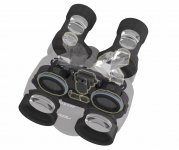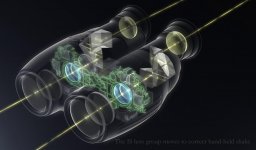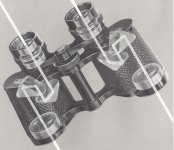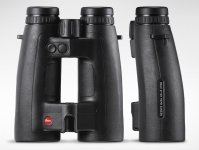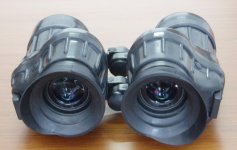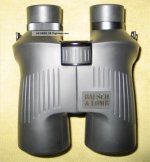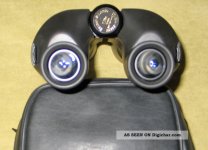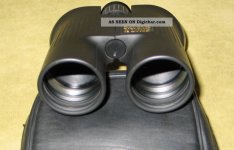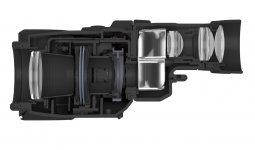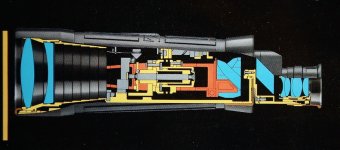-
Welcome to BirdForum, the internet's largest birding community with thousands of members from all over the world. The forums are dedicated to wild birds, birding, binoculars and equipment and all that goes with it.
Please register for an account to take part in the discussions in the forum, post your pictures in the gallery and more.
You are using an out of date browser. It may not display this or other websites correctly.
You should upgrade or use an alternative browser.
You should upgrade or use an alternative browser.
High end porro's (1 Viewer)
- Thread starter 42za
- Start date
More options
Who Replied?John A Roberts
Well-known member

Picking up on etudiant's observation . . .
Various Canon IS binoculars - including the 10x40’s - use Porro prisms in a novel configuration:
- one prism is a conventional Porro prism, and
- the other prism is in effect split in half, and then arranged so that one face is towards the objective lenses and the other towards the eyepiece lenses
(see the 2 images, one of a 10x30, and the other a 12x32 - the split prisms are positioned outboard on one and inboard on the other)
This seems to have been done so that Porro prisms could be used in the most compact possible configuration
And this in turn results in:
- minimum offset of the light path as it enters and exits the prisms, and
- the prisms orientated so that the objective and eyepiece portions of the light path are vertically aligned (and so consequently there is no lateral displacement between the objectives and the eyepieces)
Contrast this to the space occupied by the prisms, together with the offset and orientation of the light path, in a conventional Porro prism binocular (in this case a Zeiss 8x30)
If the Canon configuration was used in a conventional non-IS binocular, it would make possible a Porro prism bino looking markedly similar to Leica’s Perger prism rangefinder model
- so perhaps a pattern for a future high end Porro?
John
Various Canon IS binoculars - including the 10x40’s - use Porro prisms in a novel configuration:
- one prism is a conventional Porro prism, and
- the other prism is in effect split in half, and then arranged so that one face is towards the objective lenses and the other towards the eyepiece lenses
(see the 2 images, one of a 10x30, and the other a 12x32 - the split prisms are positioned outboard on one and inboard on the other)
This seems to have been done so that Porro prisms could be used in the most compact possible configuration
And this in turn results in:
- minimum offset of the light path as it enters and exits the prisms, and
- the prisms orientated so that the objective and eyepiece portions of the light path are vertically aligned (and so consequently there is no lateral displacement between the objectives and the eyepieces)
Contrast this to the space occupied by the prisms, together with the offset and orientation of the light path, in a conventional Porro prism binocular (in this case a Zeiss 8x30)
If the Canon configuration was used in a conventional non-IS binocular, it would make possible a Porro prism bino looking markedly similar to Leica’s Perger prism rangefinder model
- so perhaps a pattern for a future high end Porro?
John
Attachments
Last edited:
John. Don't you lose some of the 3D effect with the Canon design versus a traditional porro-prism? When I had the Canon's especially the 10x42 IS-L I didn't notice as much 3D rather they were more flat field like an SV.
MandoBear
Well-known member
Are you sure...? First I'd heard of this. Not widely available, for sure, but still listed on the Nikon Imaging website.E2 are out of production...
Peter
Huh. The Canon IS prism arrangement is a Porro 2. I never imagined this.
This is a three part WW II Leitz Porro 2 prism arrangement. Looks the same as the Canon IS’s to me: https://www.flickr.com/photos/binoc...DUW-p3Sf1n-buaft6-fmxJDT-pzYVyt-9v9jiB-xDMqds
Also note that John’s first picture seems to show the IS field lens cemented to the prism while the second picture does not.
This is a three part WW II Leitz Porro 2 prism arrangement. Looks the same as the Canon IS’s to me: https://www.flickr.com/photos/binoc...DUW-p3Sf1n-buaft6-fmxJDT-pzYVyt-9v9jiB-xDMqds
Also note that John’s first picture seems to show the IS field lens cemented to the prism while the second picture does not.
Last edited:
Omid
Well-known member

Who are still making high end porro-prism binoculars.
Fujinon 7X50 FMTRX (aka Polaris) is as high-end as you can imagine and it is a traditional Porro design.
… If the Canon configuration was used in a conventional non-IS binocular, it would make possible a Porro prism bino looking markedly similar to Leica’s Perger prism rangefinder model - so perhaps a pattern for a future high end Porro?
John, thank you for posting the cutaway diagrams of Canon IS binoculars. I really appreciate your informative posts and the detailed illustrations that usually accompany them.
The prism arrangements in the Canon IS don't seem to be any new or innovative concept. They seem to be using the same arrangement as was used in Zeiss 20X60 stabilized binoculars or other large binoculars that have a fixed pair of barrels (IPD is changed on the eyepiece side). There are a few such arrangements. See Figs 20-23 in this nice historical review:
http://www.quekett.org/wp-content/uploads/2015/09/Wise-Binocular-Microscope-Development.pdf
Regards,
-Omid
"Fujinon 7X50 FMTRX (aka Polaris) is as high-end as you can imagine and it is a traditional Porro design. "
The Fuji is a nice Astro binocular but at 54 oz. god it is heavy to carry all day birding!
The Fuji is a nice Astro binocular but at 54 oz. god it is heavy to carry all day birding!
John A Roberts
Well-known member

Dennis (post #5)
Yes, the IS Canons do loose the 3D effect of conventional Porros, as the prism entry/ exit light paths are vertically aligned
There have also been regular Porro prism (aka Porro I) binoculars where the light paths have been orientated vertically as an aid to compactness e.g.
- eyepieces higher than objectives: the 1970’s Avimo 7x42 British service binocular (see the image from Holger Merlitz’s comparative review: http://www.holgermerlitz.de/six7x40.html )
- objectives higher than eyepieces: the 1990’s B&L Elite 8x50 (the images are from the now defunct Digichar; and for additional info see: https://www.birdforum.net/showthread.php?t=245153 )
And of course there is the common inboard configuration of compact Porro binoculars (e.g. the Bushnell 7x26, and various Nikon and Pentax), which have a ‘negative 3D effect’
Frank (post #7)
Thanks for your linked post. The Canon and the Leitz versions do seem to be fundamentally the same
I was aware of the more usual 2 piece Porro II configuration, but not the previous use of the 3 piece version by Leitz (though I’m not surprised that it had been used before)
In relation to the Canon 10x30 IS, there’s a seperate side view that shows that while the field lens is close, it’s not attached to the prism
I downloaded the images from Canon’s European website but they no longer seem to be available
Omid (post #8)
I’m a keen collector of images of binocular innards, so as to better understand what’s going on
I’m also big on the idea that interesting info should be shared, and of course the notion of a picture verses a 1000 words
And while I was aware the the Zeiss 20x60’s used Porro II prisms, I was unaware of the exact detail. Thanks for the information
Finally
I was being slightly facetious in proposing the Canon style prisms for a new high end binocular. They would be a much better opportunity for a mid-price manufacturer
They could offer Swarovski Porro type on-axis resolution and transmission levels, combined with internal focus, in a compact roof prism like envelope
i.e. there would be a significant performance and brightness advantage compared to similar priced roof prisms, in what would be seen as an acceptably modern package
(think of the performance of compact inboard Porros compared to similar priced roof prism models)
John
Yes, the IS Canons do loose the 3D effect of conventional Porros, as the prism entry/ exit light paths are vertically aligned
There have also been regular Porro prism (aka Porro I) binoculars where the light paths have been orientated vertically as an aid to compactness e.g.
- eyepieces higher than objectives: the 1970’s Avimo 7x42 British service binocular (see the image from Holger Merlitz’s comparative review: http://www.holgermerlitz.de/six7x40.html )
- objectives higher than eyepieces: the 1990’s B&L Elite 8x50 (the images are from the now defunct Digichar; and for additional info see: https://www.birdforum.net/showthread.php?t=245153 )
And of course there is the common inboard configuration of compact Porro binoculars (e.g. the Bushnell 7x26, and various Nikon and Pentax), which have a ‘negative 3D effect’
Frank (post #7)
Thanks for your linked post. The Canon and the Leitz versions do seem to be fundamentally the same
I was aware of the more usual 2 piece Porro II configuration, but not the previous use of the 3 piece version by Leitz (though I’m not surprised that it had been used before)
In relation to the Canon 10x30 IS, there’s a seperate side view that shows that while the field lens is close, it’s not attached to the prism
I downloaded the images from Canon’s European website but they no longer seem to be available
Omid (post #8)
I’m a keen collector of images of binocular innards, so as to better understand what’s going on
I’m also big on the idea that interesting info should be shared, and of course the notion of a picture verses a 1000 words
And while I was aware the the Zeiss 20x60’s used Porro II prisms, I was unaware of the exact detail. Thanks for the information
Finally
I was being slightly facetious in proposing the Canon style prisms for a new high end binocular. They would be a much better opportunity for a mid-price manufacturer
They could offer Swarovski Porro type on-axis resolution and transmission levels, combined with internal focus, in a compact roof prism like envelope
i.e. there would be a significant performance and brightness advantage compared to similar priced roof prisms, in what would be seen as an acceptably modern package
(think of the performance of compact inboard Porros compared to similar priced roof prism models)
John
Attachments
Last edited:
henry link
Well-known member
...And while I was aware the the Zeiss 20x60’s used Porro II prisms, I was unaware of the exact detail. Thanks for the information
As you see in the cutaway below the The Zeiss 20x60 differs a bit from the Canons. Instead of rotating the Porros for IPD adjustment the Zeiss uses rotating rhomboid prisms.
I prefer closely spaced objectives. I would certainly have bought a B&L Elite 8x50 except for the narrow field.
Henry
Attachments
From memory the Minolta Activa 12x50 has the barrels displaced vertically, but the spacing depends on ones IPD.
This is an underrated binocular as my one is fully multicoated and has a pretty high transmission.
This is obvious as it picks up fainter stars than other 12x50s that I have.
There are other Porroprism binoculars that have a vertically displaced arrangement.
I have an Elite 10x42 but maybe it is different to the one shown above. Maybe a roof prism?
B.
This is an underrated binocular as my one is fully multicoated and has a pretty high transmission.
This is obvious as it picks up fainter stars than other 12x50s that I have.
There are other Porroprism binoculars that have a vertically displaced arrangement.
I have an Elite 10x42 but maybe it is different to the one shown above. Maybe a roof prism?
B.
Users who are viewing this thread
Total: 2 (members: 0, guests: 2)




